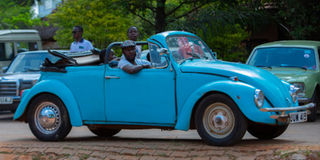Prime
Beetle is unique, practical and reliable

What you need to know:
In the 1960s, when sales of other foreign cars were dropping, the Beetle’s sales remained steady, probably because the car was dependable, easy to maintain and unique
Kikere, a Luganda word for frog, is what Volkswagen Beetles are known locally. And rightly so because the car’s headlights look more like the eyes of a frog. And from the sides, its curvy shape looks like that of a frog.
Fred Seruwo’s Beetle that he has owned for five years is not any different. A 1960 model, Seruwo recalls being chauffeured to school in the 62-year old Beetle in the 1990s. After some time of not using it, his father sold it. In 2016 as Seruwo looked for a vintage car to buy, he chanced on the VW Beetle whose documentation of ownership showed that it was the same Beetle that his father owned, he did not hesitate to buy it.
“It had gone through a number of hands but all had failed to maintain it. The owner was in the final stages of having pieces of it sold as scrap but I managed to convince him to sell it to me,” Seruwo recalls. At the time, the Beetle still had its initial registration number plate, UUM 415.
Car features
Running on a 1200cc automatic petrol engine that is positioned at the rear and the boot at the front, Seruwo’s Beetle has a maximum speed limit of 160km/hr. Seruwo says it can go as fast as 240km/hr because it overlaps its manufacturer’s mileage. And unlike modern car engines that use coolant while running, Seruwo’s is air-cooled. This is the reason it has air vents on the engine compartment cover. The more and faster you drive it, the cooler it becomes. It has four forward gears, and one reverse, to make five.
Its fuel tank carries up to 40 litres, while its dashboard is basic. It has one circular speedometre, within which the fuel gauge was technologically accommodated. Unlike your car that shows many dashboard lights, many of which are hard to interpret, the 1960 Beetle only has the battery charging and engine oil lights that display on the dashboard. The co-driver’s side has nothing but the glove box for keeping a few items.
Seruwo says his Beetle is a rear wheel drive, which generates its wheel traction power from the rear wheels. For comfort, the Beetle can accommodate four but carries up to five passengers.

The restoration
Before starting his restoration journey, Seruwo says everything on the Beetle was damaged. The floor panel was rusted and hollow while the tyres were deflated. The car was just held by the metallic rims.
Emmanuel Ssemwanga, a Volkswagen enthusiast says restoring such cars requires using spare parts and materials of the same make, and not improvisation or panel beating. It is something that costs time, effort and money.
“These cars were manufactured to last long. When you land on one, some components such as the seats may be long gone but parts such as the engine are usually just clogged with dirt which a knowledgeable mechanic can remove to keep the car on the road,” Ssemwanga says.
Because he is a mechanic, Seruwo restored most of the things on the car himself. The only component that cost him a lot was the body work that cost Shs4m. It was initially a fully covered car but during restoration, he converted it into a convertible to differentiate it from others.
This involved making the roof electronic and adding a top cover.
Apart from the body, restoring all other components cost Shs5m. Most parts were imported from the UK, Kenya and Nigeria.
“Restoration took me one and a half years. What I have relaised is that restoration is a slow process. If you work under pressure, you will never do a good job. I cannot say I have completed the restoration because it is still ongoing,” Seruwo says.
Service and maintenance
There are not many things to service on the car, except engine oil replacement. Even then, it (oil replacement) can be done after more than three years because it has no oil leakage point. If Seruwo is to do service, he sources for spare parts from Kenya. However, replacing brake fluid, engine oil, brake pads, fuel filters and bulbs in the headlamps and a few other components averagely costs Shs400,000 once in two to three years.




